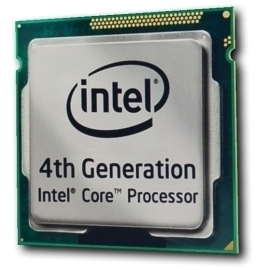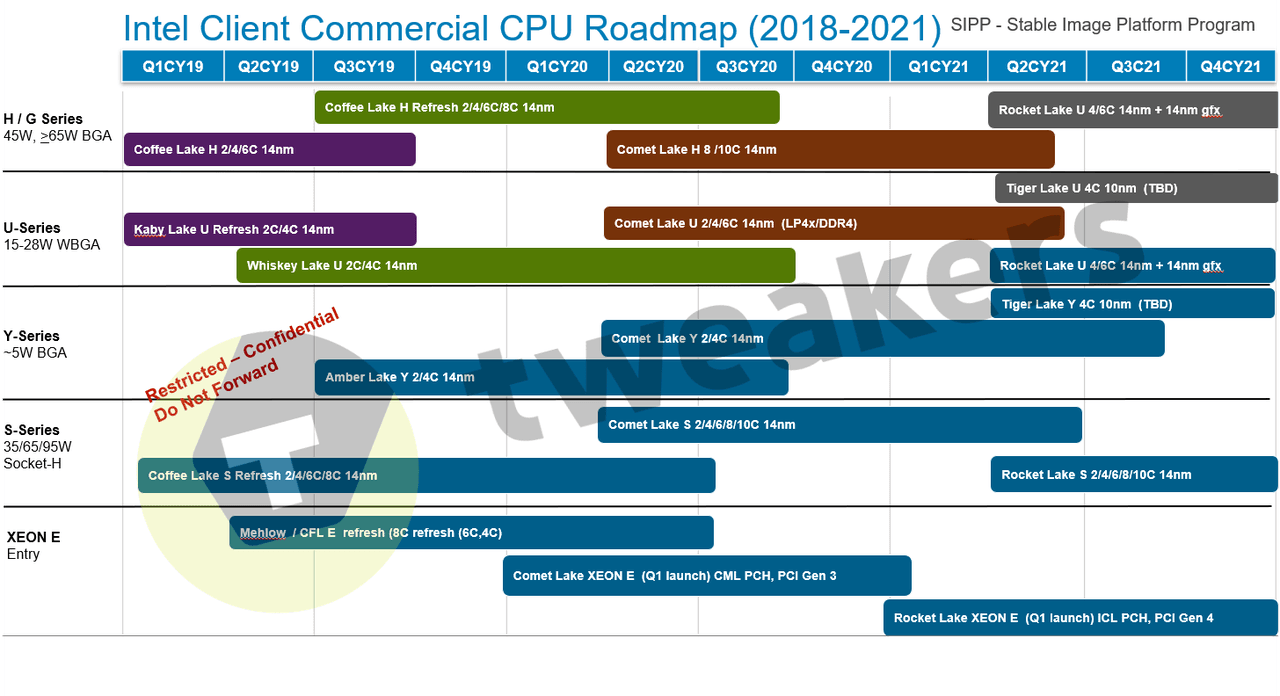Is Intel going backwards now?
Intel Rocket Lake CPUs Might Max Out With Eight Cores at 125W : Read more
Intel Rocket Lake CPUs Might Max Out With Eight Cores at 125W : Read more
Do you realize they're in opposition? Higher clock speeds is why Intel is keeping the high-end at 14 nm, while the low/mid-range is moving ahead to 10 nm (i.e. the process where it's most economical to add more cores).It wouldn't be a horrible idea to move the new uArch to the process that allows for higher clock speeds and more cores right now.
Do you realize they're in opposition? Higher clock speeds is why Intel is keeping the high-end at 14 nm, while the low/mid-range is moving ahead to 10 nm (i.e. the process where it's most economical to add more cores).
The "S" lineup is every desktop CPU for their mainstream socket, including "K" CPUs."S" series CPUs with 125wTDP? That makes little sense unless we should expect their "K" series to have 145~165w TDPs - which is probably too high for mainstream desktop.
The "S" lineup is every desktop CPU for their mainstream socket, including "K" CPUs.

 www.pugetsystems.com
www.pugetsystems.com
Yeah, it looks like it used to be that way but now they refer to their whole mainstream socketed lineup as -S.Of course it wouldn't be confusing as hell, this is Intel naming conventions we're talking about here ... I guess I was going by old info, where "S" series was a separate line from k/x altogether.

Introduction to Intel S-series Processors
If you are in the market for a new PC, you have likely had a taste of the huge variety of different Intel CPU models available. In addition to the Intel Core i3, i5, and i7 brands it turns out that there are actual two or three different product lines within each of those brands - including "K"...www.pugetsystems.com
Yeah, it looks like it used to be that way but now they refer to their whole mainstream socketed lineup as -S.
Of course it would be confusing as hell, this is Intel naming conventions we're talking about here ... I guess I was going by old info, where "S" series was a separate line from k/x altogether.

Introduction to Intel S-series Processors
If you are in the market for a new PC, you have likely had a taste of the huge variety of different Intel CPU models available. In addition to the Intel Core i3, i5, and i7 brands it turns out that there are actual two or three different product lines within each of those brands - including "K"...www.pugetsystems.com
Okay, I see your point. You think that because Intel hasn't made a > 5 core (let's not forget about that weird heterogeneous Lakefield CPU, I think it's called) @ 10 nm, it's because they can't.I would also imagine more cores is easier since Intel has yet to push past 4 cores on 10nm yet meaning that either yields are not up to snuff or there is an issue elsewhere.
This is not news. Leaked roadmaps (from 7 months ago) have shown Intel will skip 10 nm for the mainstream desktop segment. It'll stay on 14 nm through the end of 2021.If 10nm is really as broken as it appears (I think maybe it just can't do high clocks at all, or not without sucking too much power), I agree with Jimmy, not the worst idea to backport to the 14nm node in that case. If true though, that seems like an admission that 10nm has even bigger issues than ... already big issues, or, that 10nm will never work for high performance parts at least.

Okay, I see your point. You think that because Intel hasn't made a > 5 core (let's not forget about that weird heterogeneous Lakefield CPU, I think it's called) @ 10 nm, it's because they can't.
The way I see it, it's just market segmentation. Right now, 10 nm seems good only for mid-range laptop CPUs, and they didn't want to make a 6-core because that would compete too much with their high-end Comet Lake CPUs. I mean, if 10 nm were so area-limited, why the heck does Ice Lake have AVX-512 and (more to the point) up to 64 EU iGPUs? Such a large iGPU would make no sense, if their yields were too poor to manage even a 6-core part.
Anyway, their roadmap shows 10 nm, 26-core Ice Lake server CPUs in Q1 2020. So, we'll know soon enough if their current 10 nm (which I guess is technically 10 nm+) can deliver the goods.
I still don't see how that's supposed to work. So, they can make 26-core server chips but not 6-core mobile chips? If the yield on 6-core mobile chips isn't viable, the yield on 26-core chips must be atrocious - even if you have some spare cores on there.I would say yields are not good enough personally to focus on anything but higher margin server and HPC parts.
No, the reason they can't take (high-end) mobile + desktop with 10 nm is down to clock speeds. Server chips and mid-range mobile already run at lower clocks, so they're ripe for 10 nm. It's really not that hard to grasp.I could be wrong but I still doubt 10nms yields are high enough to take over mobile, desktop
I still don't see how that's supposed to work. So, they can make 26-core server chips but not 6-core mobile chips? If the yield on 6-core mobile chips isn't viable, the yield on 26-core chips must be atrocious - even if you have some spare cores on there.
No, the reason they can't take (high-end) mobile + desktop with 10 nm is down to clock speeds. Server chips and mid-range mobile already run at lower clocks, so they're ripe for 10 nm. It's really not that hard to grasp.
You are mixing up models and uArchs. -S is typically after the uArch and has for quite a while, at least since Sky Lake, meant the desktop line of chips from entry level to top end K series. S, notice no dash, after the model number is a lower power version.
Nothing has changed.

Not confusing at all ... "-s" series and "s" series -- entirely different! (and there's no dash in the chart on the article - it just says "s series" which is the same designation for the models)
In all fairness I'm starting to get used to saying "eye nine tenty nine eighty ex ee"
But the -S is not a series. Its a uArch market designation. Typically they have three, mobile, desktop (mainstream) and HEDT.
The S/K/Whatever they use is a model designation with S being low power, no letter being the normal model and K being the unlocked variant. Of course the 9900K has three of its own, K, KF and KS.
Fine, but ehe article chart literally named it "S series" -- see, everyone is confused - its not just me. 😉
Don't forget the 9900T and whatever happened to the 9900 "KFC" edition?
Intel themselves use the term "s-series"I see where they did that. It is a TH mistake though.
https://www.intel.ca/content/www/ca...sors-and-chipsets/coffee-lake-s/overview.htmlThe S-series processors [...]
Intel themselves use the term "s-series"
https://www.intel.ca/content/www/ca...sors-and-chipsets/coffee-lake-s/overview.html
Thats odd. It doesn't make sense to refer to them that way outside of internal naming. Consumers will almost never see the uArch code name.

